Krispin Joseph PX
What do we do when engaging with Food and Art on Food? Is Art of Food tasteful or evokes taste buds? What does the Western give us as an experience of Art? What do we get from the documentation of Picasso, Van Gough, and Vermeer, Art as Food culture? Are they bring only the world of beauty or taste too?
Futurist group leader Filippo Marinetti writes about Food in his ‘The Futurist Cookbook, asking the question of the perfect meal and answers like this, ‘(1) Originality and harmony in the table setting extending to the flavours and colours of the foods, and (2) absolute originality in the Food.
After the industrial age, the significance of Food changed in society and Art history. Capitalism gives Food more supremacy and delicacy. Now and then, Food is crucial for our survival, and consuming Food is one of the great pleasures in human life. The most significant thing in’ Food’ is how original it is and how we prepare and serve it.
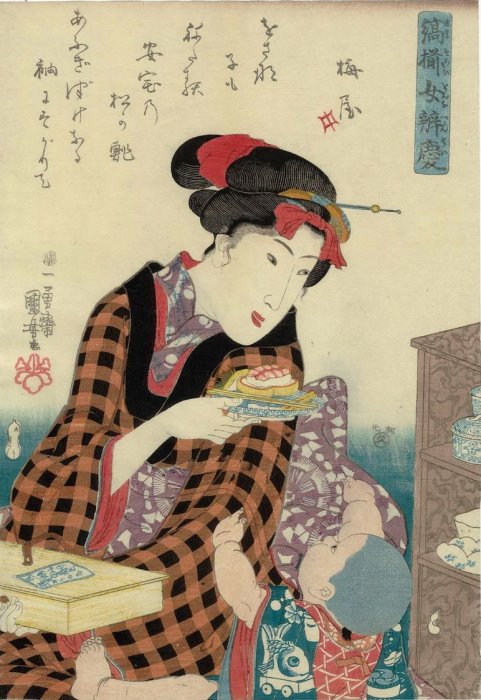
Food in Art is an extension of life and tastes; as Marinetti write, ‘the invention of appetising food sculptures, whose original harmony of form and colour feeds the eyes and excites the imagination before it tempts the lips’. Every Food is an Art, not because of the taste but of the harmony and stimulus in form. In Art history, fruits, vegetables, meat and drinks are typical motifs, and they serve as a symbol of something that provokes viewers’ gazes, and the meaning of the meal changed over time and space.
In his book, Marinetti’s text satirically narrates the story of Cooking (or making Art from Food?), such as ‘flavourful colourful perfumed and tactile food sculptures that will form perfect simultaneous meals, and the abolition of the knife and fork for eating food sculptures, which can give pre-labial tactile pleasure’.
Google Art and Culture carry ‘A Bitesize History of Food in Art’ and narrates the Food History in Art. Women in Benkei-checkered kimono Pine Trees at Ataka is a painting from Japan that tells us about the time of Japan and how hard to get Sushi for a child. This print is a part of the series portrait wearing a Kimono with a checked pattern, a pattern associated with the hero Benkei. Each print has a Kyoka poem that refers to an event in Benkei’s life or one of the many fictionalised accounts of his life. This print depicts the fictional story of a child reaching out for Sushi in Matsugasushi, the most renowned and luxurious sushi shop in Edo (the former name for Tokyo. Hand-formed Nigiri Zushi (Sushi) was developed in the early 19th century around the Bunsei era (1818–1830). The Sushi made by Sakaiya Matsugoro, whose shop is depicted in this Painting, was trendy at the time.
The theme of Food in Art is an unavoidable topic in Art and human history. That is always depicted and narrated as part of their art practice; that artwork articulates the practice and attitude on and about the Food at that time. Paintings about Food are not always about Food only, but the society and secret order of the social settings. The Fresco depicts a Woman Holding a Dish as a fresco fragment and once decorated the wall between 1-79 AD. Food and women are treated the same way in antiquity? That woman now identified as a Maenad-a follower of the wine god Bacchus, and the entire ambience reveals a wealthy Roman home and the presence of the peacock and exotic birds symbolising fertility and rebirth.
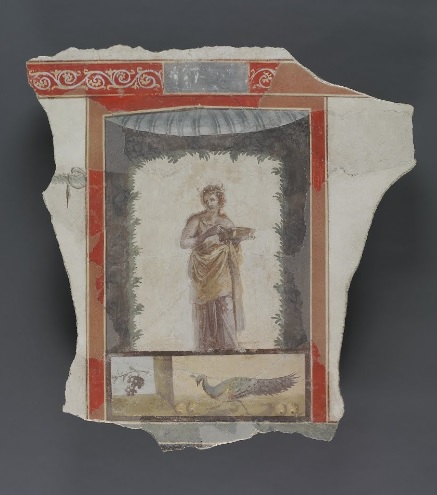
The bright red border framing the figure and the scene below has a rectangular panel with stucco imitation (white silhouettes on a blue background) inserted along the top. Parts of the white background of the wall are visible. This Fresco likely decorated a room in a Roman villa. Credit: Google Art and Culture
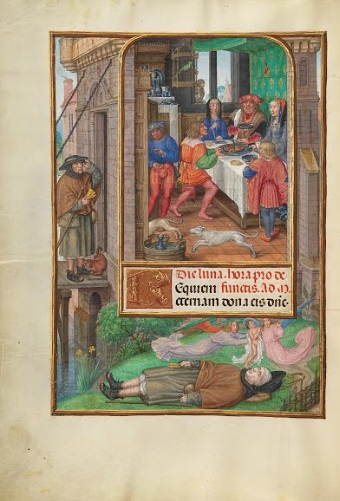
Cooked Food is always served. In medieval manuscripts, there are large images of Food preparation and consumption. This ‘The Feast of Dives’ offers us a glimpse of medieval period food culture, Food and social class, and Gender. Who cooked the Food, who served who ate? These questions are echoed in table manners and Food culture; a richly-dressed family enjoys a fancy game bird, presented with its feather on a silver platter.
His double chin and girth are clear signs of his over-indulgent habits. The artist cleverly constructed the miniature to show the house’s interior and exterior simultaneously. Credit: Google Art and Culture
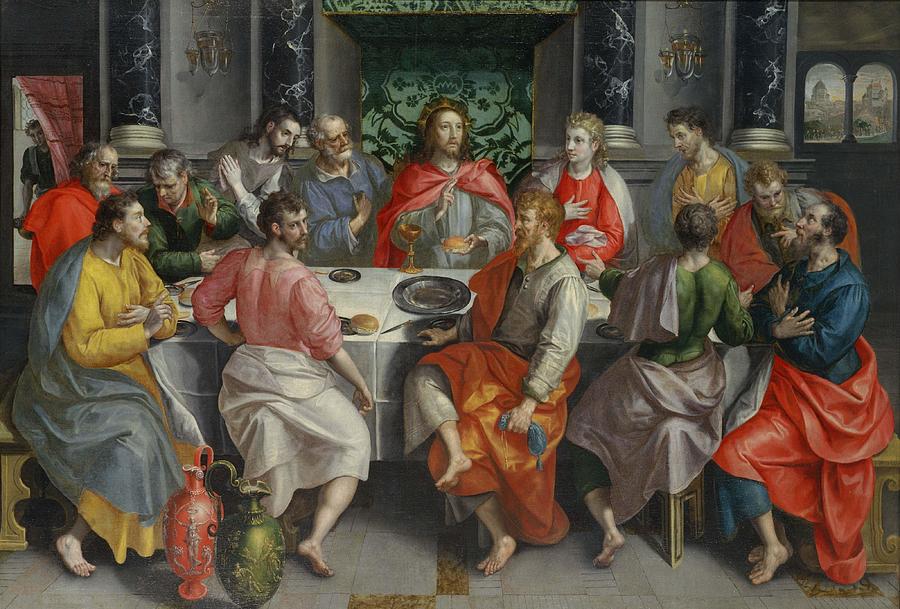
In Food in Art, no one forgets the most famous dinner hall of the Last Supper. The Painting focuses on the compositional element of betrayal; the way Judas and Jesus are depicted and portrayed in this Painting is impressive; scholars of Mediterranean Food culture argued some interesting points about the diet with stewed beans, olives, dates, fruits, and nuts. Marten de Vos’s Last Supper is brought as an example, and that grant supper is always depicted in Western Art. De Vos was a Flemish painter who lived in the time of Brueghel and Ruben; after a while of atheistic life, he returned to the Catholic faith, reflected in his Last Supper. During the period of this Last Supper, the artists’ most essential task was the repair of the various churches ruined by the Calvinists, and such restoration work was closely linked to the Counter-Reformation religious action. Food in Art is a subject that subtly depicts society’s narrative modes, and we cannot read it easily.
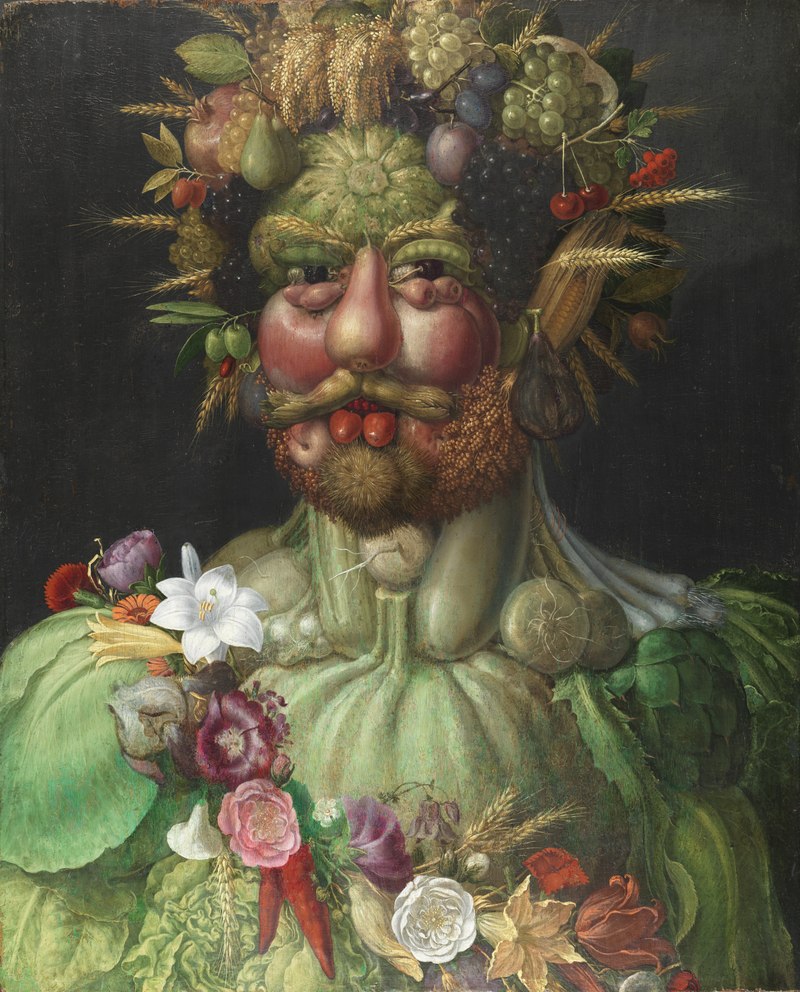
Guiseppe Arcimboldo’s The Fruit Face (1590) is famous in this genre, and this portrait was composed as an allegory that narrates Emperor Rudolf II as Vertumnus, corresponding with the seasons, with the Emperor here seen as the monarch of them all. Arcimboldo is an Italian painter who travelled to the Habsburg court in 1562 and functioned as court painter to three Emperors, Ferdinand I, Maximilian II and Rudolf II. Vertumnus is a Roman God of Seasons and growth, and the incredible variety of fruit and vegetables shows that a plenty era has returned!
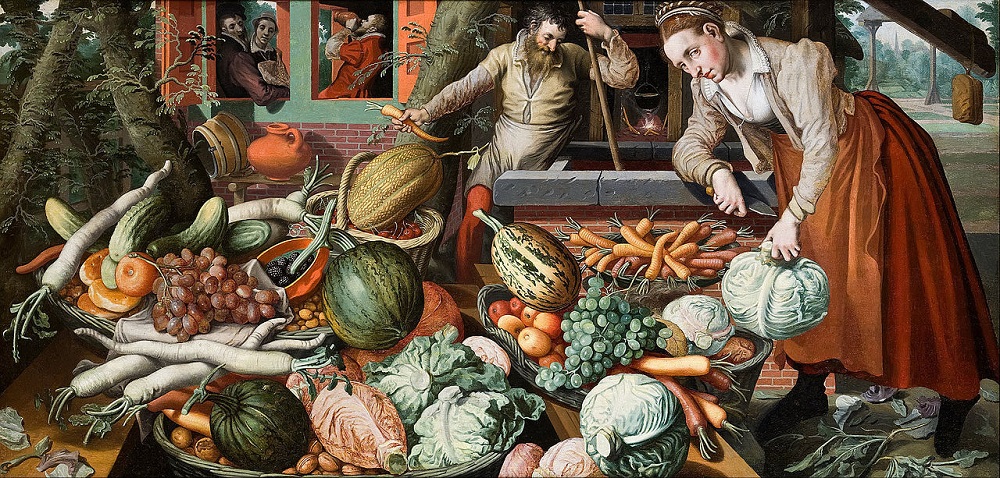
In Western Art, Food and fruits are treated as a part of religious ideas, and another genre of Painting is rare. Pieter Aertsen challenges this dilemma with his exquisite compositions. In his Market Scene (1569), he brings a new dimension of fruit and Food in public space and how Gender is visually narrating. In Market Scene, Aertsen depicts the affluence of vegetables, and a woman bends down to cut cabbage, a symbol of female sexuality, expressing publically while a man carrying a giant carrot in his hand and pointing to a cucumber nested between tomatoes. Is it an implicitly erotic story that narrates subtly?




